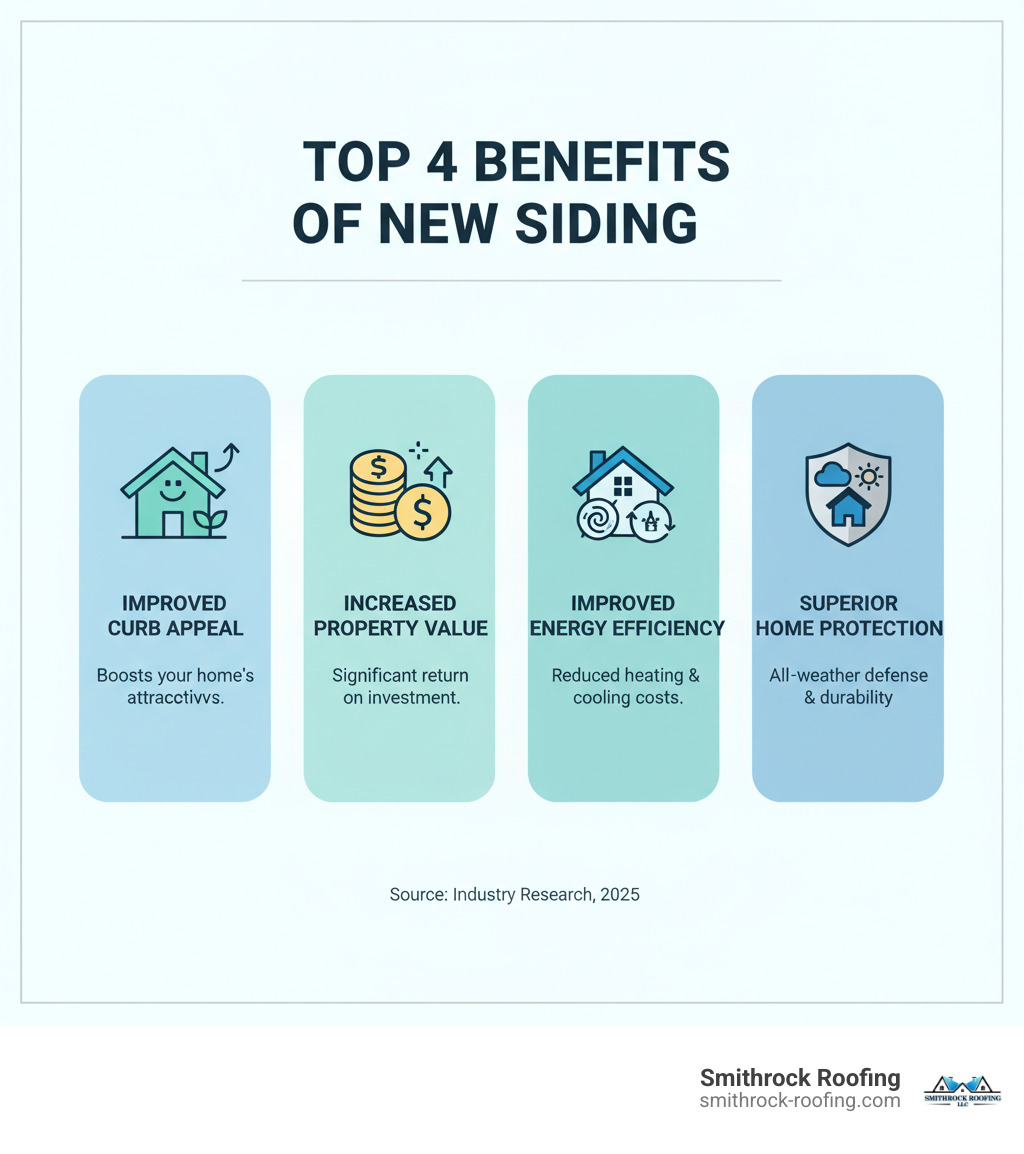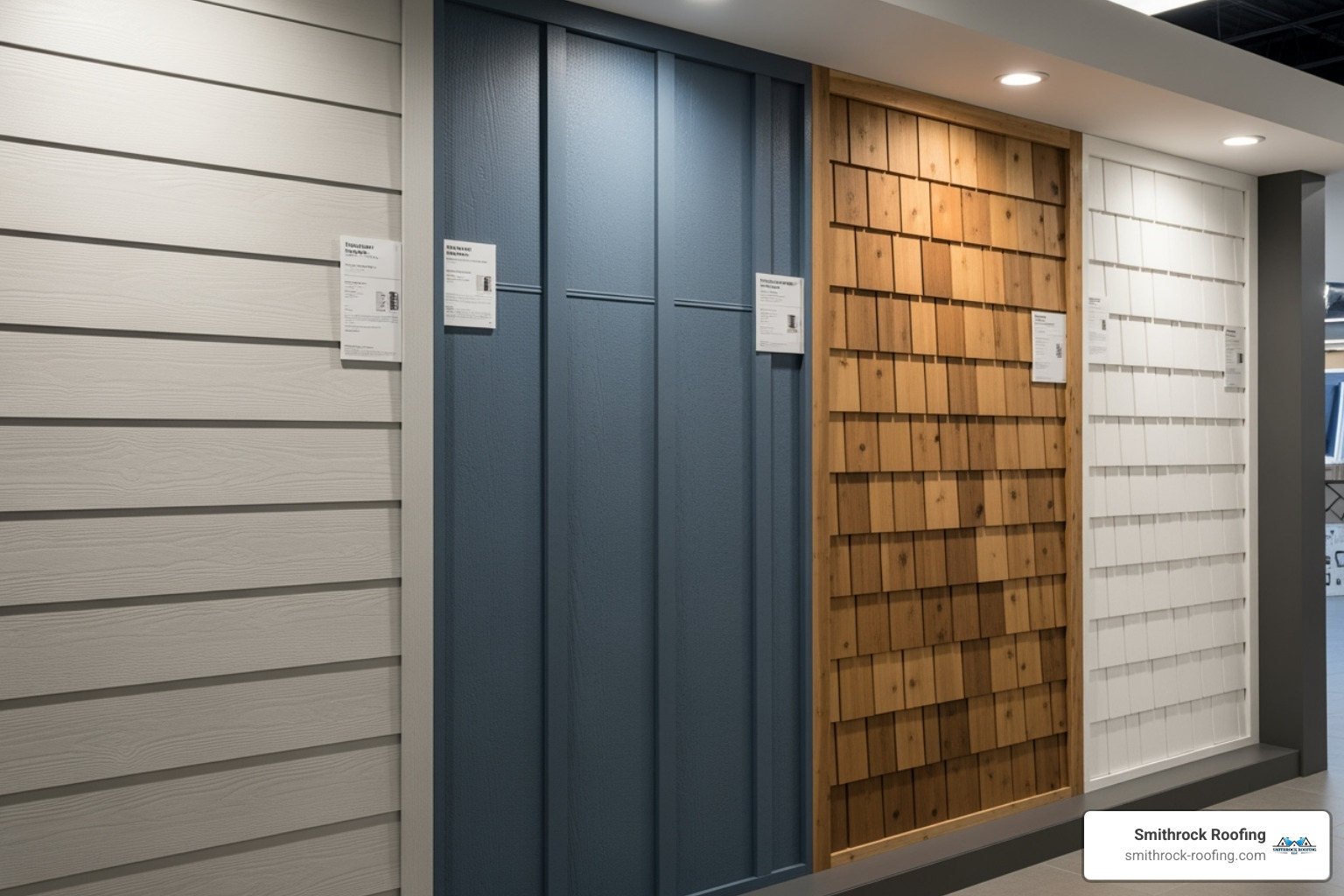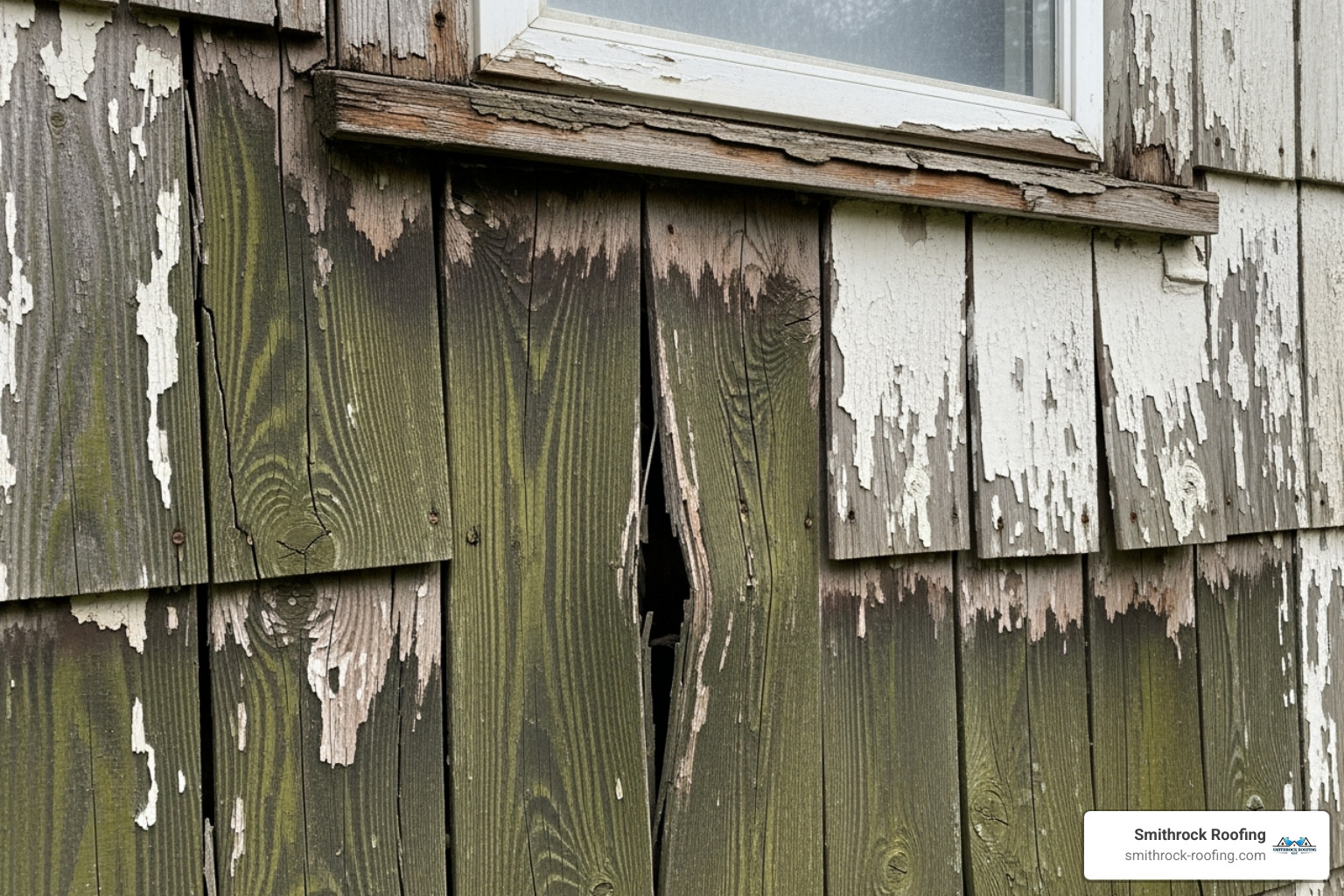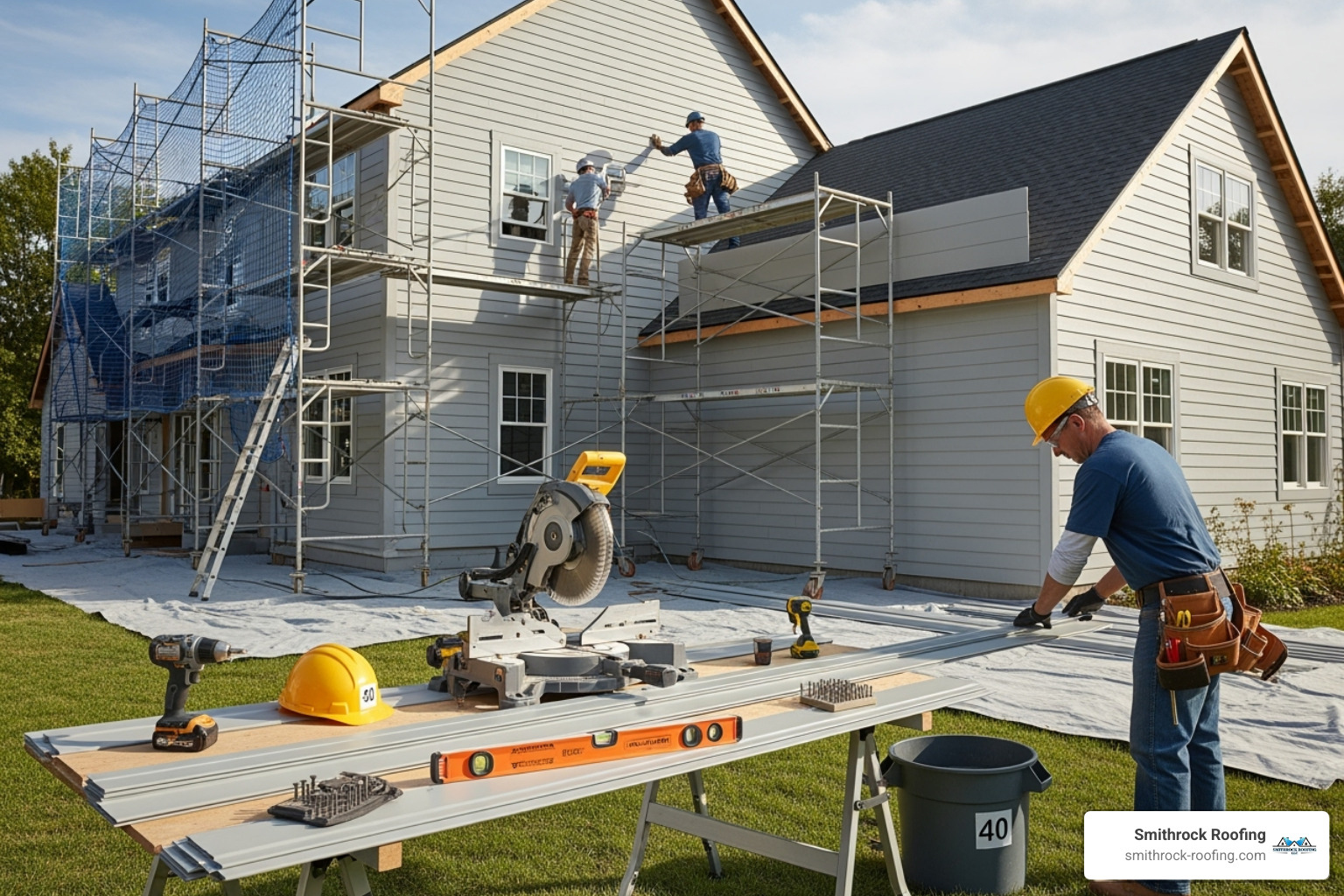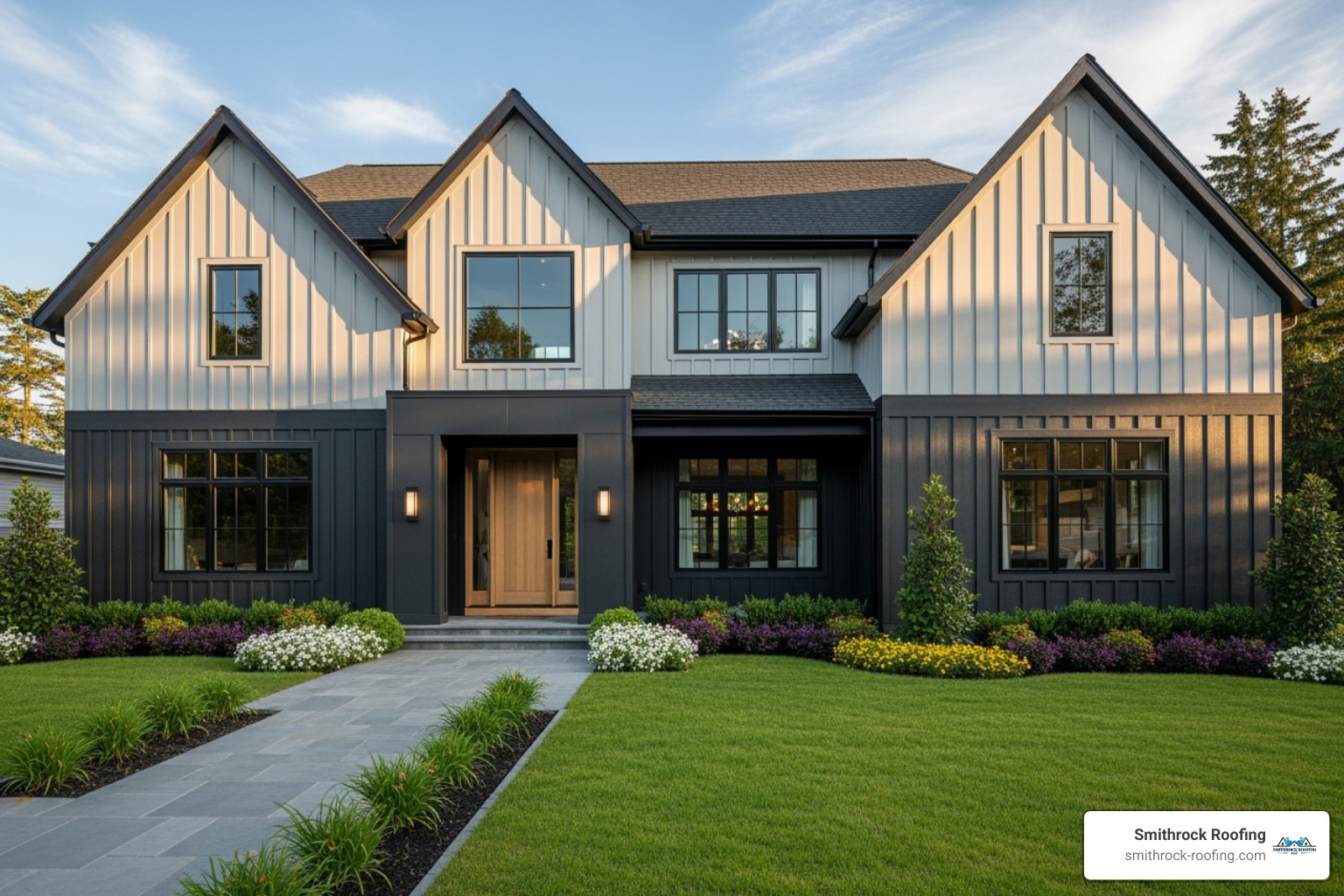Why Choosing the Right Siding Contractor Makes All the Difference
Siding contractors are the skilled professionals responsible for installing, repairing, or replacing the exterior cladding that serves as your home’s primary shield against the elements and defines its overall curb appeal. Making the right choice is not just a matter of preference; it’s a critical decision that impacts your home’s structural integrity, energy consumption, and long-term value. A subpar installation can quickly lead to a cascade of problems, including water intrusion, hidden mold growth, pest infestations, and costly future repairs. Conversely, a high-quality installation performed by a true craftsman can significantly reduce your heating and cooling costs, with studies showing potential savings of 5-30%.
A new siding project should be an exciting endeavor—it’s a unique opportunity to completely transform your home’s appearance, bolster its energy efficiency, and add a durable layer of lasting protection. Yet, for many homeowners, the process is fraught with stress and uncertainty as they realize how much is at stake. Common and costly mistakes include automatically choosing the lowest bid without scrutinizing credentials, misunderstanding the nuances of material and workmanship warranties, or simply failing to ask the right questions during the vetting process. These missteps can turn a dream renovation into a recurring nightmare.
To avoid these pitfalls and ensure a successful outcome, it is essential to vet contractors with thorough due diligence. A non-negotiable checklist should include:
- Valid Licensing and Insurance: This is your first line of defense. Verify their state-mandated credentials, general liability insurance to cover any potential property damage, and worker’s compensation to protect you from financial liability if a crew member is injured on your property.
- Material-Specific Experience: The techniques for installing vinyl, fiber cement, and wood siding are vastly different. Ensure your chosen contractor is a certified expert in your preferred material to avoid installation errors that could void the manufacturer’s warranty.
- A Strong Portfolio and Customer Reviews: Scrutinize ratings on trusted sites like the Better Business Bureau (BBB), Google, and Houzz. Look beyond star ratings to read detailed testimonials and request local references you can speak with directly.
- Detailed, Itemized Written Estimates: A professional quote is a comprehensive project plan, not just a price. It should break down all costs for labor, materials, permits, and debris removal, leaving no room for surprise charges.
- Solid, Clearly Defined Warranties: You should receive two separate warranties: a manufacturer’s warranty on the siding material itself and a contractor’s workmanship guarantee covering the quality of the installation.
This guide will walk you through the seven most important things you need to know before you sign a contract. Armed with this in-depth knowledge, you can navigate the selection process with confidence, hire a true professional, and avoid the costly regrets of a poorly executed project.

1. Not All Siding Materials Are Created Equal
The siding material you choose is a long-term investment that will profoundly affect your home’s maintenance requirements, resilience to local climate conditions, and eventual resale value for decades. This decision goes far beyond color and style. Understanding the distinct advantages, disadvantages, and installation requirements of each option is essential before you engage with siding contractors.
Understanding Your Siding Options
Let’s break down the most common materials to help you make an informed choice:
- Vinyl Siding: As the most popular siding choice in the U.S., vinyl offers exceptional affordability and low-maintenance appeal. It comes in a vast array of colors, textures, and profiles (like lap, Dutch lap, and vertical). Modern vinyl is highly resistant to fading, cracking, and pests. However, its primary vulnerability is improper installation. If nailed too tightly, it can’t expand and contract with temperature changes, leading to warping and buckling. Thinner, builder-grade panels can also be susceptible to cracking from impact.
- Fiber Cement Siding: A highly durable composite made from cement, sand, and cellulose fibers, fiber cement is a workhorse that masterfully mimics the look of wood, stucco, or stone without the associated maintenance. Brands like James Hardie are renowned for their resistance to rot, pests, fire, and extreme weather. It often comes with robust, 30-year non-prorated warranties. The downsides are its weight, which requires specialized installation techniques, and the fact that it will need to be repainted every 10-15 years. Despite the higher initial cost, its longevity and high ROI make it a premier investment.
- Wood Siding: For timeless character and natural warmth, nothing beats real wood. Options like cedar shingles or redwood lap siding offer classic, authentic appeal. However, this beauty comes at the cost of significant upkeep. Wood requires regular painting or staining (every 3-7 years, depending on the climate and finish) to prevent rot, insect damage, and moisture absorption. It’s a premium choice best suited for homeowners committed to its maintenance demands.
- Engineered Wood Siding: This material, exemplified by brands like LP SmartSide, offers a compelling middle ground. It’s made from wood strands or fibers combined with waxes and resins, then treated to resist moisture and pests. This process gives it the aesthetic of natural wood but with enhanced stability and durability, requiring less maintenance than its natural counterpart.
- Metal Siding: Increasingly popular for modern and industrial designs, steel and aluminum siding are prized for their incredible strength and minimal upkeep. Steel is exceptionally impact-resistant but can rust if the finish is deeply scratched. Aluminum is lightweight, corrosion-resistant, and won’t rust, but it is more susceptible to denting. Both are available in various profiles and handle extreme temperatures with ease.
- Stone and Brick Veneer: Whether used as a full exterior or an elegant accent, stone and brick veneer add a sense of permanence and sophistication. Manufactured stone veneer is lighter and more affordable than natural stone, making it easier to install. Both options are incredibly durable, fire-resistant, and virtually maintenance-free. While the upfront cost is among the highest, the dramatic visual impact and curb appeal are unmatched.
For a more detailed comparison for homes in the Winston-Salem area, check out our Siding Material Comparison Guide on Smithrock Roofing Blog.

How Siding Impacts Your Home’s Energy Efficiency
The right siding system can lower your heating and cooling costs by 5% to 30% by improving your home’s thermal envelope. Insulated siding, typically vinyl with a layer of contoured rigid foam insulation permanently adhered to the back, creates a thermal blanket that reduces heat transfer. This insulating capability is measured by its R-value—the higher the R-value, the greater its resistance to heat flow.
Proper installation is also critical for reducing air leakage. A professional contractor will install a weather-resistant barrier (house wrap) and meticulously seal all gaps and cracks. This prevents conditioned air from escaping and drafts from seeping in, which significantly reduces the workload on your HVAC system.
Even your siding color plays a role in energy efficiency. In warmer climates like ours in North Carolina, lighter colors reflect solar radiation, helping to keep your home cooler in the summer. In colder regions, darker colors can be beneficial as they absorb the sun’s heat. When evaluating siding, think beyond the initial cost and consider its long-term performance and impact on your monthly utility bills.
2. The Telltale Signs: Knowing When to Repair vs. Replace
An honest siding contractor will provide a transparent assessment, recommending a simple repair when it’s sufficient. However, there are times when a full replacement is the only responsible solution to address systemic failures and prevent severe underlying damage. Attempting to patch major problems is a short-term fix that can mask ongoing water damage, mold proliferation, and structural decay, leading to far more expensive and invasive repairs down the road. The key is to learn how to distinguish between a minor cosmetic flaw and a major red flag signaling a compromised system.
Signs You Can Get By with a Siding Repair
A targeted, professional repair is often the most cost-effective solution for isolated issues that have not compromised the underlying weather-resistant barrier. These situations typically include:
- Minor cracks, chips, or small holes from an impact, such as from a stray baseball or hail.
- A few loose or warped panels in a single, contained area, often caused by wind or a minor installation flaw.
- Faded or discolored paint in one section due to sun exposure, which can often be repainted to match.
- A single piece of damaged trim around a window or corner.
If the damage is limited and the house wrap beneath is still intact and performing its function, a skilled contractor can use specialized tools (like a zip tool for vinyl siding) to replace the damaged sections seamlessly, restoring your home’s protection without the cost of a full replacement.
Red Flags That Scream Full Siding Replacement
Some problems are not isolated; they are symptoms of a widespread failure that requires a complete siding replacement to protect your home’s structural integrity. Be vigilant for these critical warning signs:

- Widespread Bubbling or Blistering: This is a definitive sign that moisture is trapped behind the siding. The weather barrier has likely been breached, and water is being held against your home’s sheathing.
- Extensive Rot or Mold: Any sign of dry rot (wood that is soft, crumbly, or fungus-covered) or persistent mold and mildew indicates a serious, ongoing moisture problem. This rot can spread from the siding to the sheathing and even the structural framing of your house.
- Large Sections of Peeling Paint or Fading: While some fading is normal, widespread peeling or chalking indicates that the siding’s protective layer has failed, leaving the core material exposed and vulnerable to rapid deterioration.
- Panels Pulling Away from the House: If you see entire sections of siding that are loose, sagging, or detaching, it points to a severe structural issue. This could be failed fasteners or, more seriously, rotted sheathing that can no longer hold a nail.
- A Sudden, Unexplained Increase in Energy Bills: If your utility bills are climbing without any other explanation, your siding may be the culprit. Failing siding loses its insulating properties and allows for significant air leakage, forcing your HVAC system to work overtime to maintain a comfortable temperature.
- Interior Water Damage or Mold: Water stains on interior walls, peeling paint or wallpaper near windows, or a musty smell inside are urgent signs that your siding and weather barrier have completely failed. This is no longer an exterior problem; it’s an interior one that requires immediate attention to prevent hazardous mold growth and structural damage.
A reputable contractor will perform a thorough inspection, potentially using tools like a moisture meter, and provide a detailed explanation with photographic evidence to help you understand whether a repair or replacement is the best long-term investment for your home’s health and safety.
3. The Vetting Process for Siding Contractors is Non-Negotiable
The quality of your siding installation is arguably more important than the material you choose. Even the most expensive, high-performance siding will fail if installed incorrectly. Poor workmanship can void multi-thousand-dollar manufacturer warranties, create pathways for water damage, and negate any potential energy efficiency gains. Conducting proper due diligence when hiring siding contractors is not being overly cautious; it is the single most important step in protecting your home and your financial investment.
Must-Have Credentials for Reputable Siding Contractors
Before you even begin to discuss project details or pricing, you must verify these fundamental, non-negotiable requirements:
- Licensing and Insurance: A legitimate contractor must hold a valid state license for the work they perform. Ask for their license number and verify it with the state licensing board. Equally important, request a certificate of insurance and verify it is current. This certificate should list two types of coverage: General Liability (to cover any damage to your property) and Worker’s Compensation (to cover injuries to the crew, protecting you from being sued). Without both, you are personally and financially exposed.
- Manufacturer Certifications: Leading siding manufacturers like James Hardie (James Hardie Elite Preferred Contractor) and LP (LP BuildSmart Preferred Contractor) offer rigorous certification programs. These designations are awarded only to contractors who have been professionally trained in their specific installation standards. Hiring a certified installer is one of the best ways to ensure your manufacturer’s warranty remains fully valid.
- Deep Knowledge of Local Building Codes: An experienced local contractor understands the specific building codes and permit requirements for your municipality. This is crucial, as codes dictate everything from fastener types to flashing details. A professional contractor handles the entire permitting process, ensuring your project is safe, compliant, and structurally sound.
To learn more about why these credentials matter, see Why Choose Smithrock Roofing for Siding Projects.
Digging Deeper: Reviews, Referrals, and Portfolios
Once you’ve confirmed their credentials, it’s time to investigate their reputation and the quality of their work:
- Online Reviews: Go beyond the star rating on sites like Google, Angi, and Houzz. Read the detailed reviews, looking for patterns in customer feedback. Do clients consistently praise their communication, cleanliness, and ability to stay on schedule? Pay close attention to how the company responds to any negative reviews—a professional response shows accountability.
- Local Referrals: Ask for a list of recent customers in your local area, preferably with projects similar to yours. Don’t hesitate to call them. Ask about their overall experience, whether the project stayed on budget, and, most importantly: “Would you hire them again without hesitation?” For an even better assessment, ask for a reference from a project completed 2-3 years ago to see how the work has held up over time.
- Project Portfolios: A picture is worth a thousand words. Carefully review before-and-after photos of their past work. Look for sharp, clean lines, consistent spacing, and meticulous detail work around windows, doors, and trim. This is your best insight into their level of craftsmanship.
- Material-Specific Experience: This point cannot be overstated. Ask them directly: “How many homes have you sided with [your chosen material] in the last year?” The installation process for vinyl (which needs to hang loosely) is completely different from fiber cement (which is heavy and requires special cutting tools). An expert in one is not automatically an expert in all.
This comprehensive vetting process takes time, but it is the most reliable way to filter out unqualified operators and ensure your home is in the hands of a capable, trustworthy professional.
4. A Quote Is More Than Just a Price Tag
When siding estimates start arriving in your inbox, the natural inclination is to compare the bottom-line numbers and lean toward the lowest price. This is often a critical mistake. A suspiciously low bid is a major red flag, frequently indicating the use of inferior materials, uninsured labor, skipped steps like installing proper flashing, or simply an inexperienced or desperate operator. The most important question isn’t “What’s the lowest price?” but “What am I actually getting for my money?” A comprehensive, detailed, written estimate from your siding contractors is your single best tool for comparing apples to apples and protecting yourself from unexpected costs and disputes.
What a Detailed Siding Quote Must Include
A professional quote is a detailed project blueprint, not a one-line summary. Insist that any estimate you consider includes the following specifics:
- Itemized Costs: A clear breakdown of all anticipated expenses. This includes the specific type and quantity of siding, trim, soffit, fascia, house wrap, fasteners, and sealants. It should also list separate line items for labor, permit fees, and dumpster/debris removal costs.
- Detailed Scope of Work: This is the heart of the contract. It should provide a step-by-step description of the entire project, including: removal and disposal of old siding, a clear plan for sheathing inspection and repair, installation of a specific brand of house wrap and flashing systems, the precise installation methodology for the new siding, and a commitment to final site cleanup.
- A Clear Change Order Process: No contractor can see through walls. The quote must explicitly state how unexpected issues, such as hidden rot or structural damage, will be handled. A professional process involves stopping work, documenting the issue with photos, and providing you with a written change order detailing the additional costs for your approval before any extra work is performed.
- Project Timeline: A realistic estimate for the project’s start date, duration, and completion date, along with a mention of factors that could cause delays (e.g., weather, inspection schedules).
- Payment Schedule: A clear and fair schedule outlining the deposit amount (which should be reasonable, typically 10-30%), progress payments tied to specific project milestones (e.g., upon delivery of materials, upon completion of installation), and the final payment due only upon your complete satisfaction after a final walkthrough.
Understanding Financing Options for Your Project
A full siding replacement is a significant investment, but flexible financing options can make it much more manageable. Quality siding contractors understand this and should be able to guide you through the possibilities.
- Contractor-Offered Financing: Many established contractors partner with reputable lenders to offer convenient financing plans specifically designed for home improvement projects. These often feature competitive rates and straightforward application processes.
- Third-Party Loans: Your local bank or credit union can provide personal loans or home improvement loans. It’s always wise to shop around and compare the interest rates and terms from a few different institutions.
- Home Equity Line of Credit (HELOC): If you have built up equity in your home, a HELOC can be an excellent low-interest option. It functions like a credit card, allowing you to draw funds as needed for the project.
Discuss financing options openly with potential contractors. A customer-focused company will be transparent about the options and help you find a solution that fits your budget without forcing you to compromise on the quality your home deserves.
After you’ve checked credentials, reviewed quotes, and narrowed your list to two or three top contenders, the in-person or phone interview becomes your most powerful evaluation tool. This is your opportunity to go beyond the paperwork and gauge a contractor’s expertise, communication style, and overall professionalism. Remember, you are entrusting this person and their team with your home’s most critical protective layer. Building a rapport based on trust and clear, mutual expectations is vital. A great contractor will welcome your questions and provide thoughtful, detailed answers. If they seem evasive, impatient, or dismissive of your concerns, consider it a major red flag. For more on building a good relationship, see our guide on How to Be Happy With Your Contractor.
10 Essential Questions to Ask Potential Siding Contractors
Arrive at the interview prepared. These ten questions are designed to cut through the sales pitch and reveal the true quality and reliability of potential siding contractors.
- How long have you been in business under your current name? Longevity demonstrates stability and a proven track record in the community. A long history suggests they stand by their work.
- Can I see a copy of your state license and certificate of insurance? This is a non-negotiable starting point. A professional will have these documents ready. A good follow-up is to verify them with the issuing agencies.
- Who will be on the installation crew—your direct employees or subcontractors? This reveals their business model. While dedicated subcontractors can be excellent, companies with in-house employee crews often have more direct control over training, quality, and accountability. If they use subs, ask how long they’ve worked with them.
- What is your specific experience with my chosen siding material? Ask for details. “How do you handle expansion and contraction for vinyl?” or “What kind of blade and saw do you use for cutting fiber cement?” Their answers will quickly reveal their level of expertise.
- Can you provide me with a list of 3-4 recent, local references? Speaking to past customers is invaluable. Ask about the contractor’s communication, cleanliness, and adherence to the schedule.
- What is the projected timeline from start to finish, and what factors could cause delays? A professional can provide a realistic schedule and will be upfront about potential delays like weather, material backorders, or city inspection schedules.
- How do you protect my property (landscaping, driveway, windows) during installation? A detailed answer is a good sign. Look for mentions of using tarps for plants, plywood to protect the driveway from dumpsters, and daily site cleanup, including magnetic sweeps for nails.
- What is your process for handling unexpected issues like hidden rot or damage? A trustworthy contractor will have a clear, pre-defined process. The right answer is: “We stop work, document the issue with photos, inform you immediately, and provide a written change order for your approval before proceeding.”
- What does your workmanship warranty cover, for how long, and is it transferable? This warranty, provided by the contractor, is separate from the material warranty. Understand its length, what it covers (e.g., leaks, loose panels), its exclusions, and if it adds value to a future buyer by being transferable.
- What is the payment schedule? A standard, fair schedule involves a deposit (10-30%), one or two progress payments at key milestones, and a final payment only after the project is 100% complete and you have signed off on the final walkthrough. Be extremely wary of any contractor demanding a large upfront payment.
6. The Project Process and Warranty Are Your Safety Nets
Understanding the step-by-step project flow and the dual warranties that protect you are your essential safety nets for a large-scale siding project. A clearly communicated process minimizes stress and eliminates surprises, while strong, written warranties provide long-term peace of mind, guaranteeing both the quality of the materials and the craftsmanship of the installation.
From Consultation to Cleanup: A Typical Siding Project
A professional siding installation is a well-orchestrated process that follows a clear sequence. Here’s what you should expect when working with experienced siding contractors:
- Consultation and Material Selection: The process begins with an in-depth discussion about your goals, aesthetic vision, budget, and timeline. The contractor will assess your home’s current condition, take precise measurements, and help you finalize your siding material, color, profile, and trim details.
- Site Preparation: Before any work begins, the crew will prepare the site. This includes protecting your landscaping with tarps, moving patio furniture, and strategically placing a dumpster (often on plywood to protect your driveway).
- Removal and Inspection (The Moment of Truth): The old siding is carefully removed and disposed of. This is the most critical phase, as it exposes the home’s sheathing (the wood layer underneath). The crew will thoroughly inspect this sheathing for any signs of water damage, dry rot, or pest infestation. Any necessary repairs must be made at this stage to ensure a solid, sound foundation for the new siding.
- House Wrap and Flashing Installation: This is the critical weather-proofing stage. A high-quality weather-resistant barrier (house wrap) is installed over the sheathing, with all seams taped to create a continuous air and moisture barrier. Then, metal flashing is meticulously installed around all windows, doors, roof-to-wall intersections, and deck connections to direct water away from these vulnerable areas.
- New Siding Installation: The new siding and trim are installed with precision, strictly following the manufacturer’s specifications. This includes using the correct type of fasteners, maintaining proper spacing, and allowing for expansion and contraction to prevent future warping or buckling.
- Thorough Cleanup and Final Walkthrough: After the installation is complete, the crew performs a meticulous cleanup of the entire worksite, including a magnetic sweep to collect stray nails. Finally, you will conduct a final walkthrough with the project manager to inspect every detail of the work and ensure it meets your complete satisfaction before making the final payment.

Decoding Siding Warranties: Material vs. Workmanship
Your siding project is protected by two distinct warranties that work in tandem. It is crucial to understand the difference:
- Material Warranty: This warranty is provided by the manufacturer of the siding product (e.g., James Hardie, LP, CertainTeed). It covers defects in the product itself, such as premature fading, cracking, or delamination, under normal conditions. These warranties are often for long periods, such as 30 years. However, they almost always contain a clause stating that the warranty is void if the product is not installed according to the manufacturer’s exact specifications. This is why hiring a certified installer is so important.
- Workmanship Warranty: This warranty is provided directly by your siding contractor. It covers the quality of the installation itself. If a problem arises due to an installation error—such as improper fastening that leads to loose panels, or incorrect flashing that results in a leak—this warranty ensures the contractor will return to fix the problem at no cost to you. Reputable contractors offer comprehensive workmanship warranties, sometimes for 10 years, 25 years, or even a lifetime, as a testament to their confidence in their work.
When reviewing warranties, look for a non-prorated warranty. This means the warranty provides 100% coverage throughout its entire term. A prorated warranty, in contrast, decreases in value over time, meaning you would be responsible for a larger portion of the replacement cost as the years go by. Always get all warranty details in writing and read the fine print to understand the terms, conditions, coverage, and any transferability clauses.
7. Siding Trends Can Boost Curb Appeal and Resale Value
Your home’s siding is its largest single design feature, making the biggest statement and forming the basis of its curb appeal. As siding contractors working across the Winston-Salem area, we’ve seen firsthand how thoughtful, modern design choices can dramatically transform a home’s appearance and significantly increase its market value. The key is to strike a balance between current trends and timeless style to ensure your investment looks great for years to come.
Popular Siding Colors and Styles Today
Homeowners are increasingly moving beyond traditional beige and embracing more dynamic and sophisticated looks that add personality and distinction:
- Dark and Bold Colors: Deep, moody colors are in high demand. Rich charcoal grays, bold navy blues, and earthy forest greens create a modern, upscale feel that commands attention. When choosing a dark color, ensure your siding material (especially vinyl) is rated for it to prevent heat-related warping.
- High-Contrast Trim: The classic combination of dark siding with crisp white trim is more popular than ever. This high-contrast look makes architectural details like windows, gables, and rooflines pop, creating a sharp, clean aesthetic.
- Mixed Materials and Textures: Adding a secondary material or texture creates visual interest and a custom look. This is often done by combining traditional horizontal lap siding on the main body of the house with accents like stone or brick veneer around the foundation, or using cedar shakes or board and batten in the gables.
- Vertical and Board & Batten Siding: This style, once associated with barns and farmhouses, has become a staple of modern design. The strong vertical lines can make a home feel taller and more stately. It’s often used on entire homes for a clean, contemporary look or as an accent to break up long walls of horizontal siding.
For more inspiration, visit the Smithrock Roofing Blog.

Choosing a Look That Lasts and Adds Value
While trends are exciting, the goal is to choose a look that you will love for decades and that will appeal to future buyers. Follow these principles to ensure lasting value:
- Complement Your Home’s Architecture: The most successful designs work with, not against, the home’s inherent style. A sleek, vertical metal siding might look out of place on a historic Colonial, just as ornate trim would on a mid-century modern ranch.
- Consider Your Neighborhood and Environment: Take a drive around your neighborhood. While you don’t have to match your neighbors exactly, your choices should feel harmonious with the surrounding homes and natural landscape. Also, be sure to check for any HOA restrictions on color or material.
- Prioritize Timeless Appeal: Classic styles like lap siding, board and batten, and natural-looking stone accents have endured for a reason. They provide a beautiful canvas that can be updated over the years with new paint colors or landscaping.
- Use Visualization Tools: Making a final decision can be daunting. Many siding contractors and manufacturers now offer powerful visualization tools. These apps allow you to upload a photo of your own home and “try on” different siding materials, styles, and colors, helping you make a confident final decision.
Ultimately, a siding replacement project offers one of the highest returns on investment of any home improvement project. According to Remodeling Magazine’s annual Cost vs. Value report, homeowners can often recoup a significant percentage of the project cost upon resale, with fiber cement siding replacement consistently ranking as one of the top-performing projects.
Conclusion
Armed with the essential knowledge from this guide, you are now prepared to navigate your siding project with confidence and clarity. You understand the critical differences in siding materials, how to spot the warning signs of failure, and what to demand in a comprehensive quote and a protective warranty. Most importantly, you have a clear roadmap for how to properly vet siding contractors to find a trustworthy, skilled partner who will safeguard your most valuable asset.
A siding replacement is one of the most impactful and transformative improvements you can make to your home. When executed correctly by a true professional, it dramatically boosts curb appeal, enhances energy efficiency, and adds significant, lasting value. However, achieving all these benefits is entirely dependent on choosing the right contractor for the job.
At Smithrock Roofing, we have proudly served homeowners throughout Winston-Salem, Greensboro, High Point, and the surrounding communities for years. Our guiding principle is simple: treat your home as if it were our own. This means we use only high-quality materials, employ skilled craftsmen, take no shortcuts, and ensure your complete satisfaction from start to finish. We stand behind our work with comprehensive, long-term warranties because we are confident in the quality and durability of our installations.
You deserve a contractor who communicates clearly, delivers on every promise, and provides the profound peace of mind that comes with expert, worry-free installation.
Ready to transform your home’s exterior and protect your investment for decades to come? Let’s start the conversation.
Get your free, detailed siding estimate today!
